The Effect of a Large Backfill Area on Grounding Grid Performance
Abstract
:1. Introduction
2. The Simulation Model of Massive Soil Surface
2.1. Simulation Model Establishment
2.2. Secondary Peak of Step Voltage
3. The Influence of Backfill Material Parameters on the Secondary Peak of Step Voltage
3.1. The Effect of Length L on the Secondary Peak of Step Voltage and Grounding Resistance
3.2. The Influence of Thickness h on Step Voltage and Ground Resistance
3.3. The Influence of Slope on Stepping Voltage and Grounding Resistance
3.4. The Influence of Resistivity on Step Voltage and Grounding Resistance
4. The Grounding Simulation Test
4.1. The Test Platform and Test Method
4.2. Analysis of Test Result
5. Analysis and Discussion
6. Conclusions
- (1)
- Large areas of backfill with low resistivity are the main cause of secondary peaks of step voltage.
- (2)
- Increasing the length of backfill soil can reduce the secondary peak of step voltage and the grounding resistance. Increasing the resistivity of large areas of backfill can also reduce this peak, but the grounding resistance would also increase.
- (3)
- It is feasible to simulate large areas of backfill with agar gel, which can be used in the multi-level grounding simulation tests.
- (4)
- In engineering practice, the secondary peak of step voltage can be reduced by expanding the scope of construction and dealing with backfill soil.
- (5)
- When the earthwork of the substation is carried out, a small slope could be built at the edge, which could reduce the risk of accidents outside the station and, at the same time, reduce the amount of digging and filling, which can save costs.
Author Contributions
Conflicts of Interest
References
- Capelli, F.; Riba, J.-R.; Pérez, J. Three-Dimensional Finite-Element Analysis of the Short-Time and Peak Withstand Current Tests in Substation Connectors. Energies 2016, 9, 418. [Google Scholar] [CrossRef] [Green Version]
- Guide for Safety in AC Substation Grounding; IEEE 80-2000; The Institute of Electrical and Electronics Engineers, Inc.: New York, NY, USA, 2000.
- Sun, W.; He, J.; Gao, Y.; Zeng, R.; Wu, W.; Su, Q. Optimal design analysis of grounding grids for substations built in non-uniform soil. IEEE Trans. Power Appar. Syst. 2000, 3, 1455–1460. [Google Scholar]
- Hajiaboli, A.; Fortin, S.; Dawalibi, F.P. Numerical Techniques for the Analysis of HVDC Sea Electrodes. IEEE Trans. Ind. Appl. 2015, 51, 5175–5181. [Google Scholar] [CrossRef]
- Dolado, P.; Lazaro, A.; Delgado, M.; Peñalosa, C.; Mazo, J.; Marin, J.M.; Zalba, B. An Approach to the Integrated Design of PCM-Air Heat Exchangers Based on Numerical Simulation: A Solar Cooling Case Study. Resources 2015, 4, 796–818. [Google Scholar] [CrossRef]
- Takahashi, T.; Kawase, T. Calculations of earth resistance for a deepdriven rod in a multilayer earth structure. IEEE Trans. Power Deliv. 1991, 6, 608–614. [Google Scholar] [CrossRef]
- Hua, X.U.; Wen, X.; Ling, H. Optimization Design of Grounding Grid of Large Substation. High Volt. Eng. 2005, 31, 6365. [Google Scholar]
- Visacro, S.; Alipio, R. Frequency dependence of soil parameters: Experimental results, predicting formula and influence on the lightning response of grounding electrodes. IEEE Trans. Power Deliv. 2012, 27, 927–934. [Google Scholar] [CrossRef]
- IEEE Recommended Practice for Grounding of Industrial and Commercial Power System; IEEE Std. 142-1991; IEEE: Piscataway, NJ, USA, 1991.
- Calixto, W.P.; Neto, L.M.; Wu, M.; Yamanaka, K.; da Paz Moreira, E. Parameters estimation of a horizontal multilayer soil using genetic algorithm. IEEE Trans. Power Deliv. 2010, 25, 1250–1257. [Google Scholar] [CrossRef]
- Gouda, O.E.; Amer, G.M.; EL-Saied, T.M. Optimum design of grounding system in uniform and non-uniform soils using ANN. Int. J. Soft Comput. 2006, 1, 175–180. [Google Scholar]
- Zhao, Z.; Cui, X.; Zhang, B.; Li, L. Analysis of grounding systems in multi-layer soil with finite volumes of different resistivities. Proc. Chin. Soc. Electr. Eng. 2004, 24, 218–223. [Google Scholar]
- Gyung, S.K.; Hyong, J.G.; Park, D.-W. Simulator for potential distribution analysis. J. Eng. Technol. 2012, 7, 225–229. [Google Scholar]
- Thabet, A. Grounding Systems of Electric Substations in Non-Uniform Earth Structure with New Analysis. Master’s Thesis, High Institute of Energy, Aswan, Egypt, 2002. [Google Scholar]
- Pereira, W.; Soares, M.; Martins, N.L. Horizontal multilayer soil parameter estimation through differential evolution. IEEE Trans. Power Deliv. 2015, 31, 622–629. [Google Scholar] [CrossRef]
- Long, X.; Dong, M.; Xu, W.; Li, W. Online Monitoring of Substation Grounding Grid Conditions Using Touch and Step Voltage Sensors. IEEE Trans. Smart Grid 2012, 3, 761–769. [Google Scholar] [CrossRef]
- Dawalibi, F.P.; Mitskevitch, N.; Allard, G. Grounding analysis of large hydroelectric generating complex using soil structure containing heterogeneous volumes. In Proceedings of the 17th CEPSI, Macau, China, 27–31 October 2008. [Google Scholar]
- Nahman, J.; Paunovic, I. Effects of the local soil nonuniformity upon performances of ground grids. IEEE Trans. Power Deliv. 2007, 22, 2180–2184. [Google Scholar] [CrossRef]
- Liu, J.; Dawalibi, F.P.; Mitskevitch, N.; Joyal, M.-A.; Tee, S. Realistic and accurate model for analyzing substation grounding systems buried in various backfill material. In Proceedings of the 2014 IEEE PES Asia-Pacific Power and Energy Engineering Conference (APPEEC), Hong Kong, China, 7–10 December 2014; pp. 1–6. [Google Scholar]
- Fortin, S.; Mitskevitch, N.; Dawalibi, F.P. Analysis of grounding systems in horizontal multilayer soils containing finite heterogeneities. IEEE Trans. Ind. Appl. 2015, 51, 5095–5100. [Google Scholar] [CrossRef]
- Wei, G.; Huang, W.; Wen, X.; Wei, W.; Hailiang, L.U.; Yao, S.; Tan, B.; Li, W. A study of grounding parameters of grounding grid in soil with massive texture by using fast multipole boundary method. Proc. CSEE 2014, 34, 1436–1445. [Google Scholar]
- Gouda, O.E.; El Dein, A.Z. Ground potential rise of faulty substations having equal and unequal spacing grounding grids conductors. IET Gener. Transm. Distrib. 2017, 11, 18–26. [Google Scholar] [CrossRef]
- Substation Grounding Programs; EPRI TR-100622; SGSYS Version 4.4; Product ID: TR-100622-V3; Electric Power Research Institute: Palo Alto, CA, USA, 1992; Volume 3.
- El-Morshedy, A.; Zeitoun, A.G.; Ghourab, M.M. Modeling of substation grounding grids. IEE Proc. C 1986, 133, 287–292. [Google Scholar]
- Webster, J.G. Electrical Impedance Tomography; Institute of Physics Publishing: London, UK, 1990. [Google Scholar]
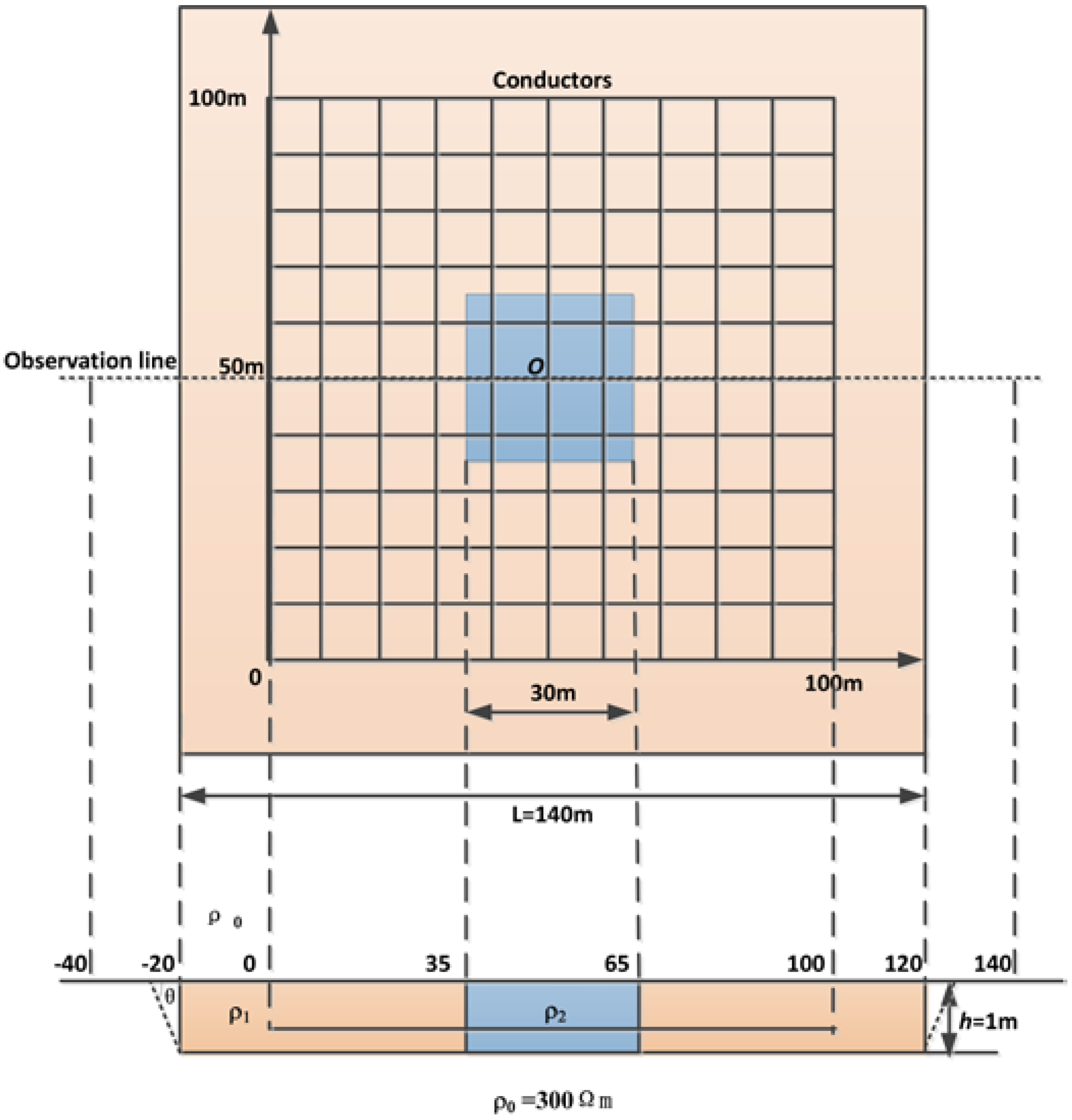

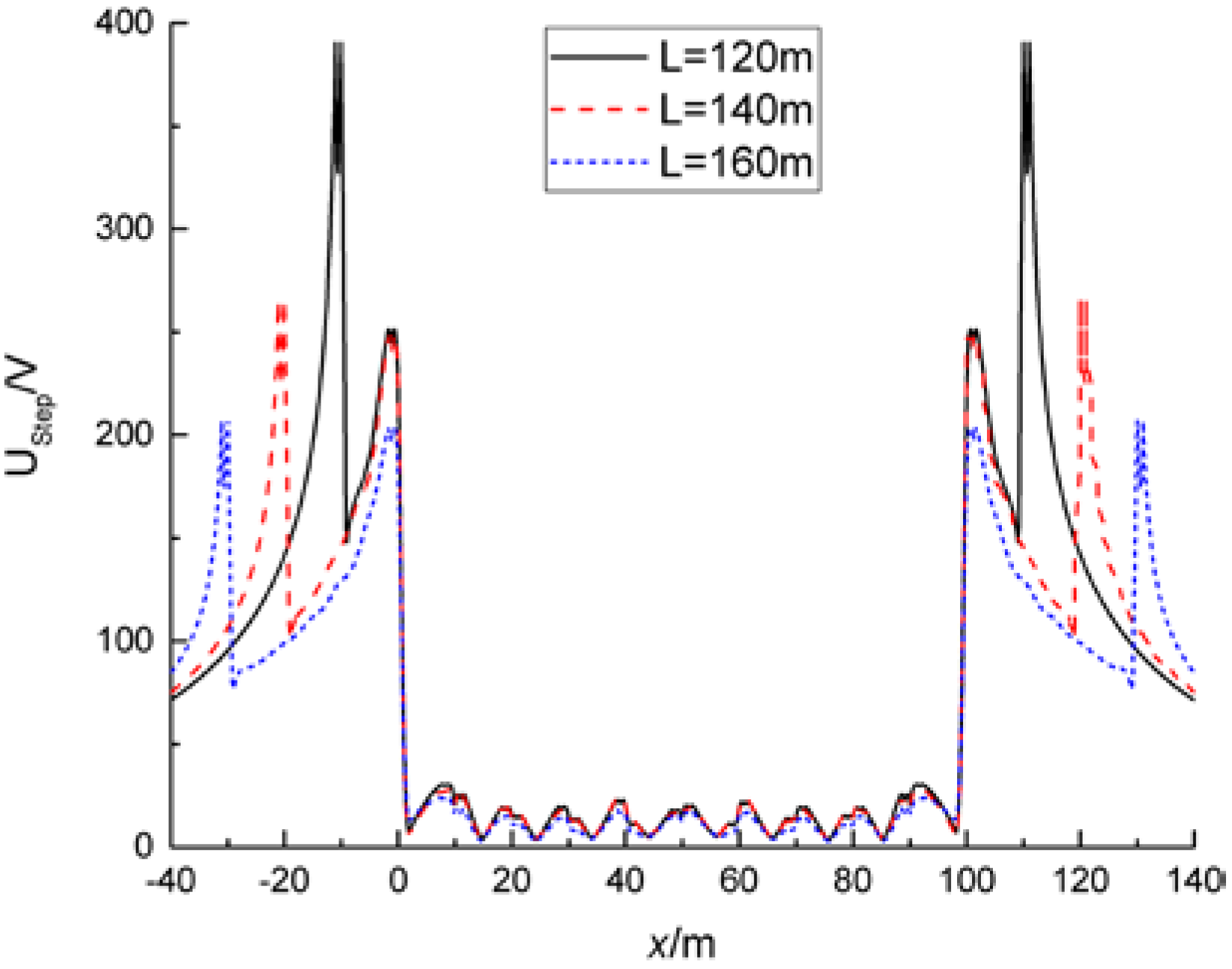
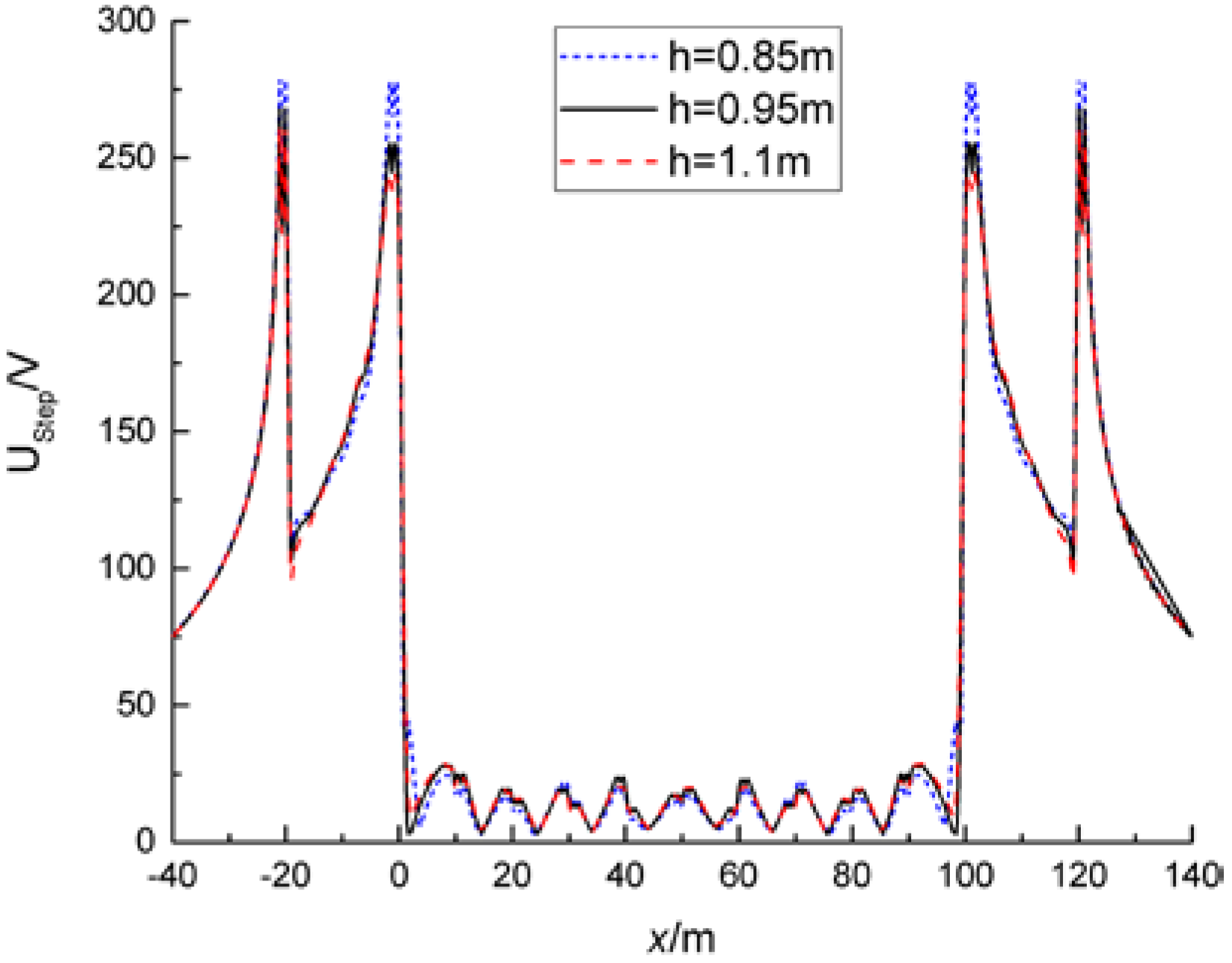
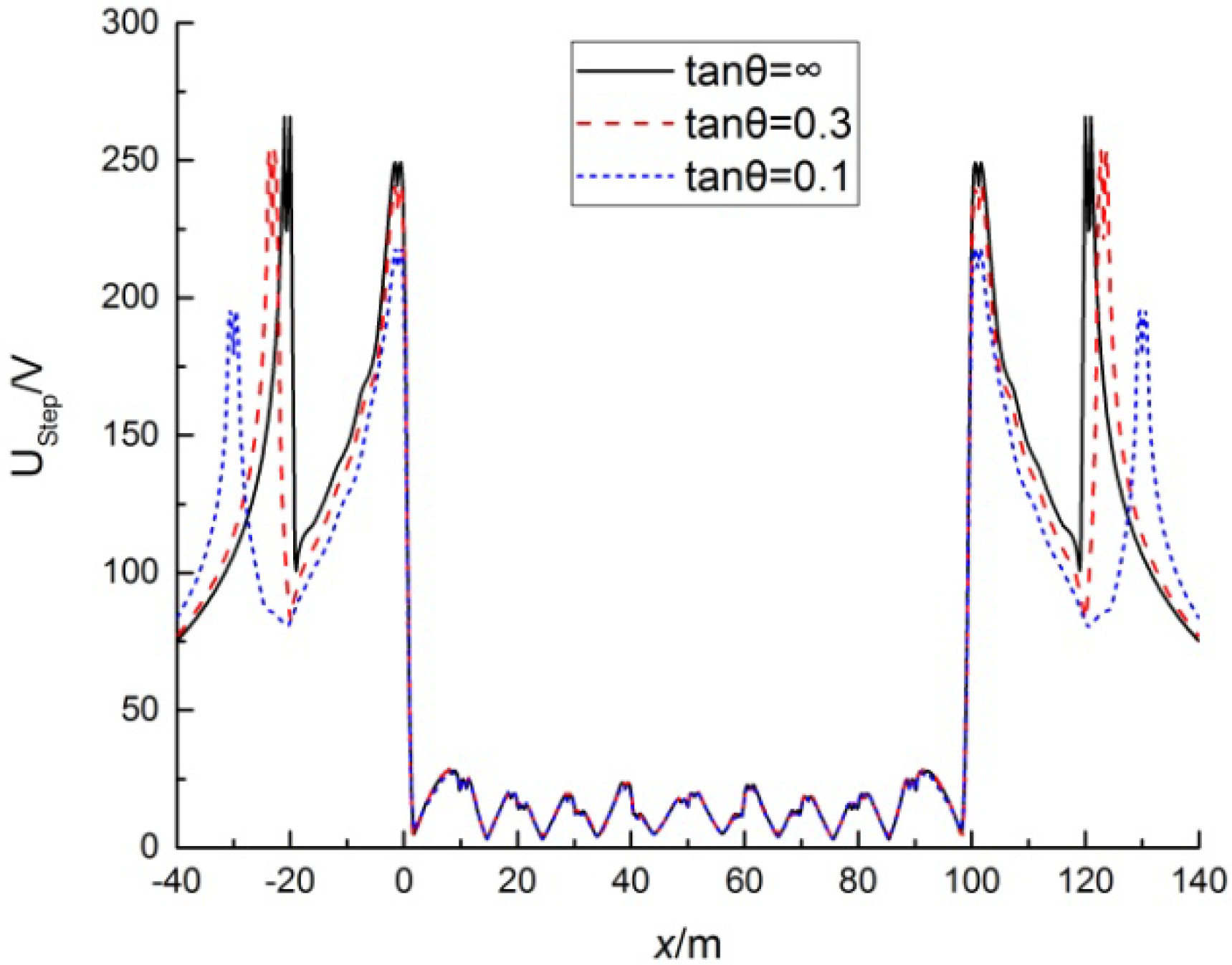

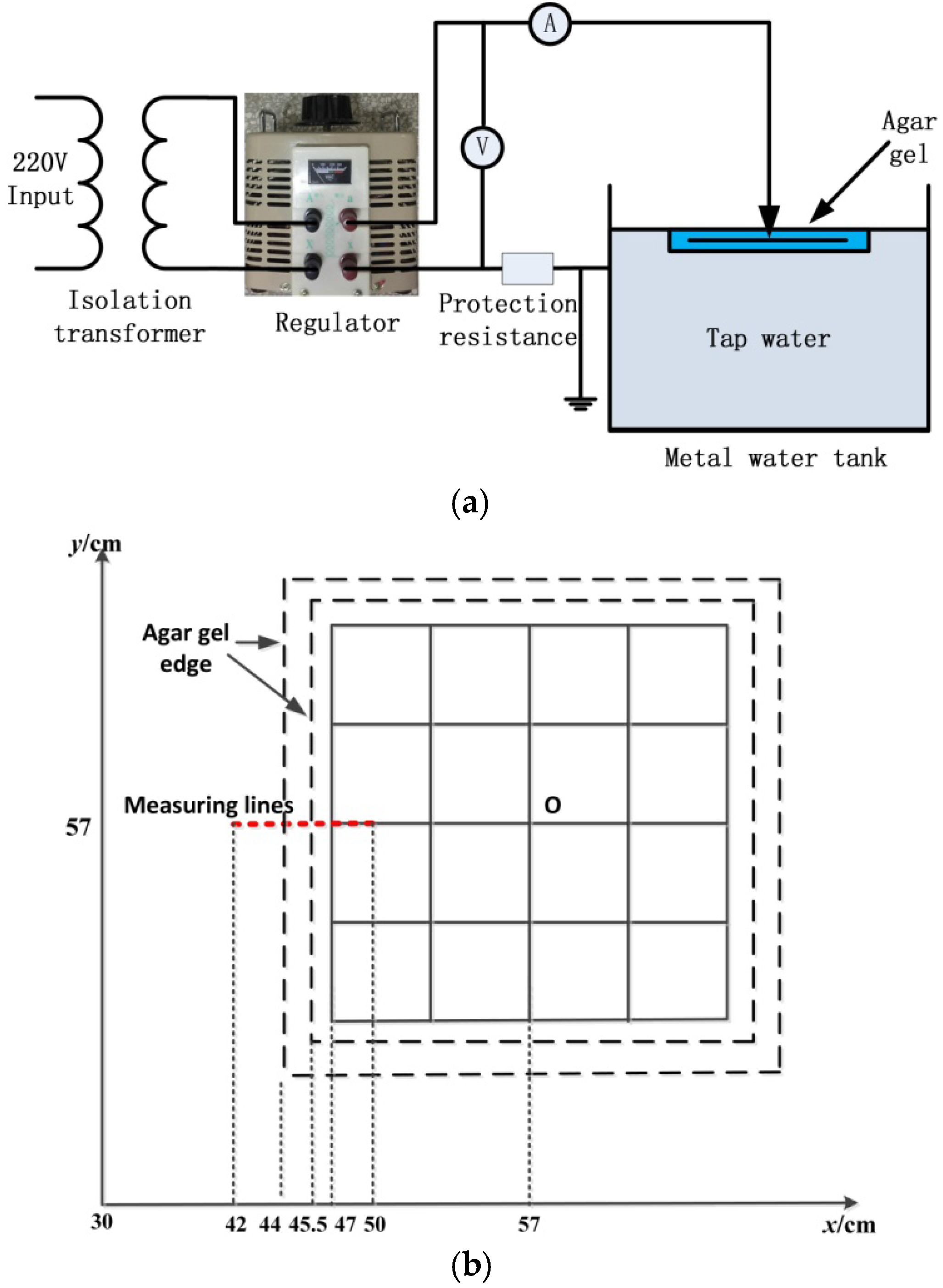


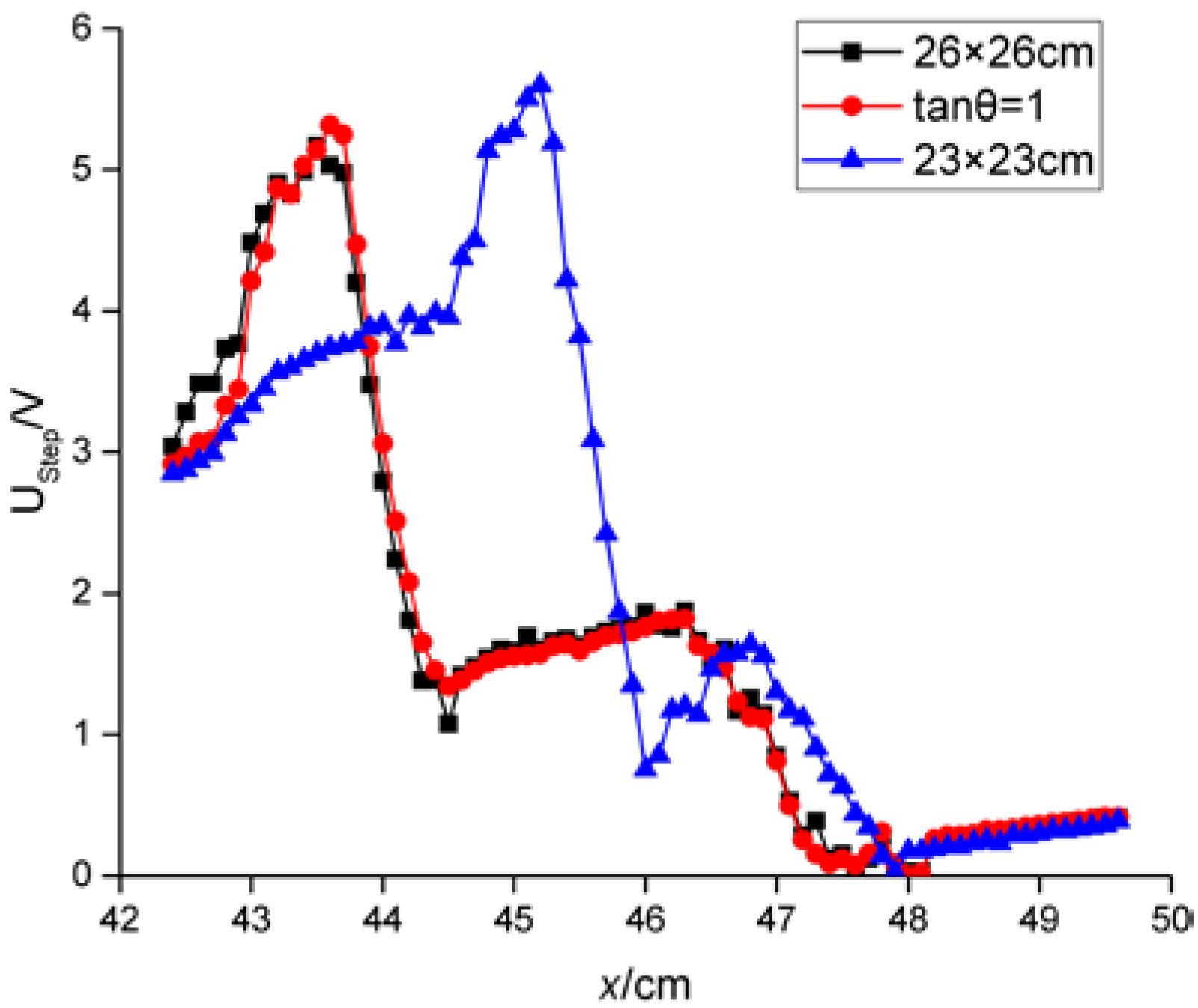
| Influence Factors | GPRmax/V | Grounding Resistance/Ω | |
|---|---|---|---|
| length | L = 120 m | 11,984.65 | 1.198465 |
| L = 140 m | 11,529.62 | 1.152962 | |
| L = 160 m | 10,985.42 | 1.098542 | |
| thickness | h = 0.85 m | 12,014.67 | 1.201467 |
| h = 0.95 m | 11,529.62 | 1.152962 | |
| h = 1.1 m | 11,493.23 | 1.122057 | |
| slope | tan θ = 1 | 11,490.13 | 1.149013 |
| tan θ = 3 | 11,522.3 | 1.15223 | |
| tan θ = ∞ | 11,529.62 | 1.152962 | |
| resistivity | ρ1 = 10 Ωm | 10,866.99 | 1.086699 |
| ρ1 = 30 Ωm | 11,529.62 | 1.152962 | |
| ρ1 = 100 Ωm | 12,570.81 | 1.257081 | |
| Agar Gel Size/cm | Agar Gel Resistivity/Ωm | Grounding Resistance/Ω |
|---|---|---|
| 26 × 26 | 0.95 | 10.03 |
| 1.96 | 10.35 | |
| 3.75 | 10.86 | |
| 23 × 23 | 0.95 | 10.39 |
| 1.96 | 10.73 | |
| 3.75 | 10.97 |
| Agar Gel Size/cm | 26 × 26 | Higher Surface 26 × 26 Lower Surface 23 × 23 | 23 × 23 |
| Grounding resistance/Ω | 10.35 | 10.49 | 10.73 |
© 2018 by the authors. Licensee MDPI, Basel, Switzerland. This article is an open access article distributed under the terms and conditions of the Creative Commons Attribution (CC BY) license (http://creativecommons.org/licenses/by/4.0/).
Share and Cite
Tao, Y.; Wei, J.; Li, Q.; Shi, Y.; Zhang, T.; Zhang, J.; Liu, X. The Effect of a Large Backfill Area on Grounding Grid Performance. Energies 2018, 11, 698. https://doi.org/10.3390/en11040698
Tao Y, Wei J, Li Q, Shi Y, Zhang T, Zhang J, Liu X. The Effect of a Large Backfill Area on Grounding Grid Performance. Energies. 2018; 11(4):698. https://doi.org/10.3390/en11040698
Chicago/Turabian StyleTao, Yaguang, Jianchun Wei, Qingquan Li, Yalin Shi, Tongqiao Zhang, Jiwei Zhang, and Xiao Liu. 2018. "The Effect of a Large Backfill Area on Grounding Grid Performance" Energies 11, no. 4: 698. https://doi.org/10.3390/en11040698





